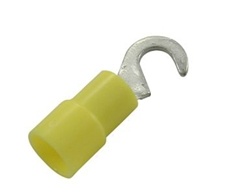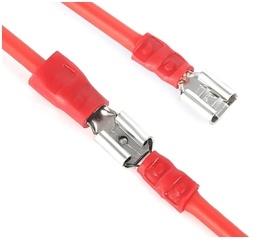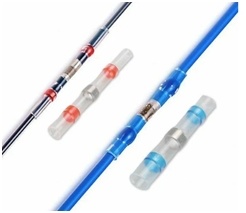Terminal wire harnesses type and description
Publish:
2025-06-04 18:26
Source:
Terminals are crucial components to any cable assembly and wire harness process. By definition, a terminal is part of a class of electrical connectors used for the transfer of electrical currents from a grounding source or power. The terminal of a wire or cable also indicates the point at which the conductor, from a component, device, or network, comes to an end. The multitude of cable applications introduces a wide selection of terminal variations and types. Each project consists of specified requirements that lead to the use of some terminals over others. SAISONIC supplies customers will all kinds of terminals harness , effectively integrating the necessary parts for a successful cable assembly!
There are two main combinations in cable terminals: insulated and non-insulated.
According to the specified cable assembly project, either of the two variants is the preferred choice for high-quality product performance.
1.Insulation provides an additional protective cover to prevent water and other moisture from entering the wires. Insulating materials can be nylon, heat-shrinkable materials or vinyl materials, serving as non-conductive wires.
2. Non-insulating is usually used when no additional wire protection is required. In addition, non-insulated wires have a lower manufacturing cost and thus prove to be more economically valuable.
Terminal type
1. Ring terminal

A circular terminal on which screws or studs can be easily fixed.
The circular terminals are either crimped or welded to the wires.
There are two types: insulated and non-insulated.
Common applications: Ring terminals are typically used in the automotive industry.
This shape is highly suitable for connecting various contactors or mechanical relays to automotive engines and circuits.
2. Fork terminal (Spade)
An open shovel termi nal for convenient use, allowing for easy connection or removal from screws.
nal for convenient use, allowing for easy connection or removal from screws.
There are two types: insulated and non-insulated.
Common applications: Wire harness assembly projects are usually composed of closely spaced installation Spaces, so shovel terminals are mostly used. The shovel provides reliable and fast weld-free electrical connection.
3. Hook terminal
 A kind of terminal that is convenient to use and has an open end.
A kind of terminal that is convenient to use and has an open end.
The produced insulated or non-insulated hook structures provide simple and durable connections for various projects.
Common applications: The simple hook design allows for an easy-to-use terminal that is durable and efficient.
Therefore, examples that require wire connectors are the most common hook terminal applications.
4. Quick disconnection terminal
 The quick disconnection terminal provides convenient and reliable use, offering a simple connection and disconnection of two wires. Produce insulating or non-insulating products.
The quick disconnection terminal provides convenient and reliable use, offering a simple connection and disconnection of two wires. Produce insulating or non-insulating products.
Common applications: Quick disconnection terminals can be found in a wide range of automotive, industrial and consumer products.
As one of the fastest ways to connect and disconnect two wires, this terminal is easy to reuse and highly efficient.
5. Bullet terminal
The bullet ter minal is connected to the male connector and the open circular female connector to form a high-quality connection.
minal is connected to the male connector and the open circular female connector to form a high-quality connection.
The connection with the bullet terminal helps prevent corrosion and other potentially harmful substances from entering the wire harness.
Common application: In the automotive industry, bullet heads are used for quick and simple wiring connections.
The bullet design provides a durable connection that can be easily assembled and disassembled during the manufacturing process.
6. Butt terminal
 The butt terminal connects or terminates a single or multiple wires. They help prevent wear and tear and cutting. This additional protection helps prevent moisture, corrosion and other negative factors. The butt terminal is a simple solution for extending wires because it can match and connect wires.
The butt terminal connects or terminates a single or multiple wires. They help prevent wear and tear and cutting. This additional protection helps prevent moisture, corrosion and other negative factors. The butt terminal is a simple solution for extending wires because it can match and connect wires.
Common application: In various industries, butt terminals safely terminate any given wire. In addition, another common use is to connect one wire to another.
7. Flag terminal

Terminals that provide convenient and secure connections. The marking terminal works well in narrow Spaces and when the quick disconnection is too large. Provide quick and convenient connection and disconnection. There are also two types: insulated and non-insulated. For example, 187,110,205,250
Common applications: In applications that require frequent connections, enhance the reliability of the terminal.
SAISONIC terminal wire harness service
SAISONIC is committed to outstanding quality, punctual delivery and competitive industry prices, enabling customers to trust SAISONIC to meet all end demands. The extensive manufacturing diversity within the company ensures the appropriate product assembly with the highest level of expertise. For more information about terminal wiring harnesses, please contact us
Prev:
Related News
The History of Battery Cables: From Inception to Modern Advancements
The History of Battery Cables: From Inception to Modern Advancements Table of Contents 1. Introduction to Battery Cables 2. The Early Beginnings of Battery Cables 3. Key Developments in Battery Cable Technology 4. The Role of Materials in Battery Cable Evolution 5. Modern Advancements in Battery Cables 6. Applications of Battery Cables in Various Industries 7. Future T
Jun 06,2025
Terminal wire harnesses type and description
Terminals are crucial components to any cable assembly and wire harness process. By definition, a terminal is part of a class of electrical connectors used for the transfer of electrical currents from a grounding source or power. The terminal of a wire or cable also indicates the point at which the conductor, from a component, device, or network, comes to an end. The multitude of cable applications introduces a wide selection of terminal variations and types. Each project consists of specified requirements that lead to the use of some terminals over others. SAISONIC supplies customers will all kinds of terminals harness , effectively integrating the necessary parts for a successful cable assembly!
Jun 04,2025
Understanding Solar Cables: The Backbone of Solar Energy Systems
In the realm of renewable energy, solar cables play a pivotal role in ensuring the efficient transmission of electricity generated by solar panels. These specialized cables are designed to withstand the demanding conditions of outdoor environments while maintaining optimal performance and safety standards. Understanding the nuances of solar cables is crucial for anyone involved in the installation
Jun 03,2025
Exploring the Benefits of Using a High-Speed Micro USB Cable
Exploring the Benefits of Using a High-Speed Micro USB Cable Table of Contents Introduction to High-Speed Micro USB Cables Understanding Micro USB Technology Benefits of High-Speed Micro USB Cables Enhanced Charging Efficiency Fast Data Transfer Compatibility and Convenience How to Choose the Best Micro USB
May 31,2025
Understanding Motor Control Cables: A Guide for Electrical Professionals
Motor control cables are specifically designed to connect electrical motors to control systems, ensuring seamless communication and operational efficiency. These cables are engineered to withstand the demanding environments typically associated with motor control applications, which often include exposure to heat, moisture, and mechanical stress. A key characteristic of motor control cables is the
May 28,2025
